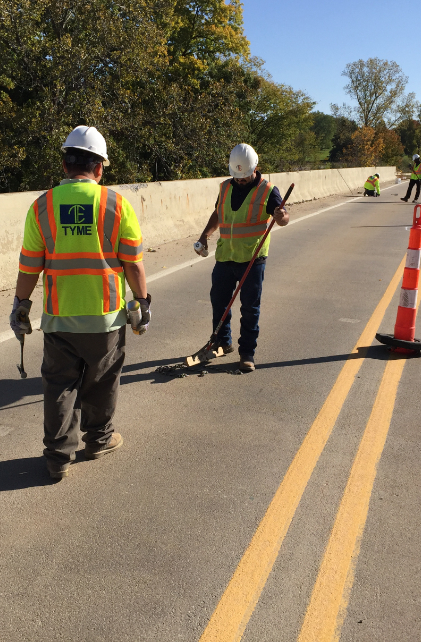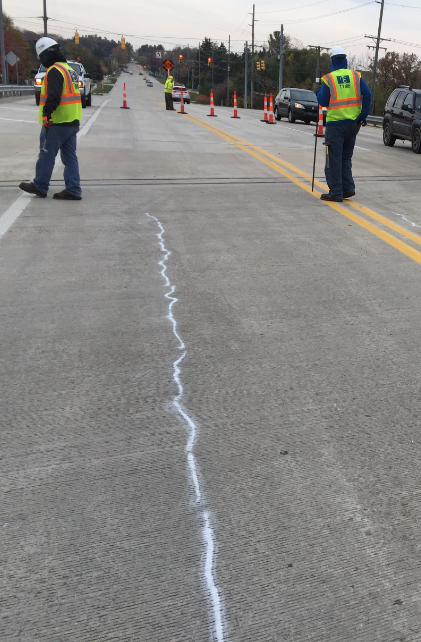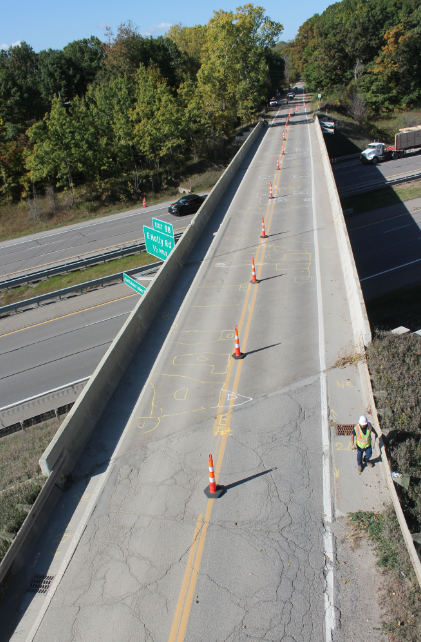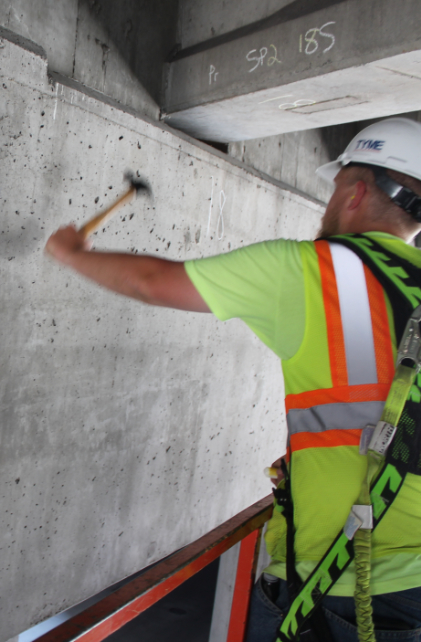Condition Assessment of Structures
Condition Assessment of Structures
Existing structures undergo deterioration during their service life due to the effects of service loads, environmental exposure, normal wear-and-tear, inadequate maintenance or debilitating events.
Since these structures are designed for certain serviceability and durability requirements, there is a need to examine the structure to ascertain their fitness for service periodically of following some unusual events. The process by which this is done is known as condition assessment, which involves close inspection of the structure or selected portions of it to collect data which is used to evaluate and assess the condition of the existing structure. Depending on the purpose of the assessment the data can be used to develop the scope of repairs needed to restore the structure to an acceptable condition.
Condition assessment is typically driven by the need for maintenance, repair, and rehabilitation, change in use or ownership; to retrofit for code compliance or repair damage caused by debilitating events; etc. Each structural condition assessment project depends on the type of structure and the purpose. Experience and engineering judgement are required to develop a detailed plan of work that would adequately cover the type of condition assessment required.
For bridge structures the purpose of the condition assessment can be to restore the bridge disrepairs and maintain its owner’s desired system rating. This is commonly termed bridge scoping, and the project generally includes determination of a repair strategies and development of the preliminary cost estimates. It can also be for the purpose of monitoring the condition of the bridge to ensure that its strength, serviceability, or durability are not compromised because of deterioration, normal wear and tear, or debilitating events. In this case the data is compiled and stored in the appropriated database, and any observed issues are reported to the owner for their timely attention. This is the “safety inspection of in-service bridges”, a program required of all owners of public bridges, such as the state DOT’s.
Condition Assessment of Structures
TYME Consulting Engineers, Inc is a company that specializes in providing bridge scoping services. We evaluate different repair options for bridges and recommend the most cost-effective solution. Additionally, we have access to the necessary equipment for thoroughly inspecting all parts of a bridge.
Site Review (Overall Physical Assessment of the Bridge Condition)
- In-Depth Structural Inspection of Bridge Components
In-depth structural inspection of all bridge components is a comprehensive examination of the structural elements of a bridge, including the foundation, substructure, and superstructure. The purpose of an in-depth structural inspection is to identify any issues or defects that may affect the safety and integrity of the bridge, such as corrosion, cracking, structural damage, spalls, or delamination. The findings of an in-depth structural inspection are used to develop a repair or maintenance plan to address any identified issues and ensure the continued safe and efficient operation of the bridge.
- Destructive Material Testing (Coring)
Destructive material testing, also known as coring, is a method of evaluating the properties of a material by removing small samples or “cores” from it. This type of testing is typically performed on concrete, steel, and other construction materials used in bridges. The samples are then tested in a laboratory to determine the material’s compressive strength, tensile strength, pantographic analysis, and other properties. The results of these tests are used to determine the overall condition of the material and can be used to identify any potential issues such as corrosion, cracking, or deterioration. Coring is considered destructive because it involves removing material from the bridge and is typically done when non-destructive testing methods are not sufficient or when more detailed information is needed.
- Non-Destructive Testing (Steel Beam End Measurements)
Non-destructive testing (NDT) is a method of evaluating the properties of a material or structure without causing any damage to it. One specific type of NDT is steel beam end measurements, which is used to evaluate the properties of steel beams used in bridges. This test is used to measure the dimensions of the steel beams and to determine their structural integrity. The test is done by attaching a sensor to the end of the beam, which sends a wave through the beam and records the time it takes for the wave to travel through the beam and back. By analyzing the wave speed, it is possible to determine the thickness of the steel and any defects such as corrosion, cracking, or deformation. This type of testing is non-destructive, as it does not cause any damage to the steel beam, it is useful for inspections that need to be done frequently and can be done while the bridge is still in service.
- Scour
Scour is a major concern for bridges, as it can lead to the erosion of soil and sediment around the foundations of a bridge, weakening its structural integrity. Scour can be caused by a variety of factors, including changes in the flow of water, changes in the water’s velocity, changes in the water’s depth, and changes in the water’s temperature. Bridges that cross rivers, streams, and other bodies of water are particularly vulnerable to scour. There are several methods that engineers can use to protect bridges from scour. One common method is to install scour protection measures around the foundations of the bridge. These can include rock riprap, gabions, or other types of erosion-control structures.
Engineering Survey (Evaluation of Site findings, and choosing best repair strategy)
- Best Repair Option Selection:
Selecting the best repair option for a bridge depends on several factors, including the condition of the bridge, the type of damage or deterioration, the available budget, and the expected future use of the bridge. Tyme Consulting Engineers, Inc typically use a combination of visual inspections, non-destructive testing, and destructive material testing to evaluate the condition of a bridge and identify any issues that need to be addressed. Once the condition of the bridge has been assessed, engineers will evaluate different repair options and consider factors such as cost, feasibility, and expected longevity, patching, structural repairs, rehabilitation, and replacement.
- Calculation of Quantities:
Calculating the quantities of materials and labor needed for a bridge project is an important step in the design and construction process. Tyme Consulting Engineers, Inc use a variety of methods to determine the quantities of material and labor required for a bridge project which include estimating quantities of material, labor, and take-off.
- Analysis of Life Cycle Cost:
Life cycle cost (LCC) analysis is a method used to evaluate the total cost of owning and operating a bridge over its entire life span. It considers not only the initial construction costs, but also the costs of ongoing maintenance, repairs, and eventual replacement. LCC analysis is used to compare different design options and determine the most cost-effective solution over the long term.
As part of the Federal Bridge Management regulation, the National Bridge Inspection Standards (NBIS) established the national bridge database; regulate inspection procedures, frequency of inspections, qualification of personnel, and structure of inspection reports. It requires each state to prepare and maintain an inventory of its bridge structures. Under the NBIS, inventory and appraisal data must be collected, tabulated and entered in the Structure Inventory and Appraisal (SIA) sheet retained by the state Department of Transportation (DOT), to be accessible to the Federal Highway Administration (FHWA).
Bridge inspection essentially consists of the systematic inventory data collection, engineering condition assessment and appraisal, and tabulation and reporting of the bridge components or member rating and inventory data. The bridge owner maintains a file of each bridge, containing records of inspection findings, maintenance records/recommendations, and the record is updated by documenting and tracking subsequent inspection findings.
Inspection is conducted in accordance with the AASHTO Manual for Condition Evaluation of Bridges, the Bridge Inspection Reference Manual and other MDOT Guidance documents. During the inspection the data required to complete the Bridge Inspection Report (BIR) is gathered. The BIR itself is a collection of various forms, documents and reports, depending on the bridge and the inspection findings.
Inspection consist of a visual evaluation and spot testing/checking of the bridge components and members, will largely be conducted from the shoulder. If a more detailed observation and/or Non-Destructive Testing (NDT) over live traffic are deemed necessary, the QTL will contact the MDOT-PM who will make the final determination and arrangements on how to proceed. The inspection team will be comprised of a Qualified Team Leader (QTL) and Field Staff assistants with bridge inspection training and experience. The QTL is the bridge inspector of record and will be present at all times during the field inspection.
Field Inspection
This involves visiting each bridge structure and immediate environ to observe and identify all member or elements and note areas, extents, and severities of deterioration. It is easily the most consequential aspect of all the bridge inspection tasks as it is the source of the information from which the bridge element and/or member rating is derived. As noted earlier, it is the systematic engineering assessment of the bridge element conditions. For this reason, it must be accurate, comprehensive, and timely and strictly adhere to the NBIS requirements.
The inspection will be performed in accordance with Manual for Condition Evaluation of Bridges and, the Bridge Inspection Reference manual; and it will comply with the requirements for “Routine” inspection. This will include a visual inspection and the use of non-destructive testing, when necessary. Electronic photographs will be taken to document the current elevation view of the bridge and any unusual conditions. All photos will be well captioned, describing what the photo is showing. The photos will be clear for use in properly documenting the inspection. The photos will include any load posting signs with the bridge in the back ground. This photo will be attached to the Structure Inventory and Appraisal form and submitted to MDOT. A discussion of some of the methods employed in the inspection is given below
Concrete Elements
All deteriorated areas of the deck, including spall, patch, heavy scaling, severe cracking, etc. will be noted. There may be need to spot check with hammer sounding severely distressed surfaces that are accessible The underside of the deck will be visually inspected for wet areas, efflorescence, transverse cracking, longitudinal cracking, map cracking, delamination, spall, rust stains or any other evidence of deterioration. Areas of previous repairs, in place false decking, and loose concrete will be noted. Pictures, descriptions, and locations of the deterioration will be documented to be included in the report. All substructure units, including the backwalls, will be visually inspected for signs of vertical or lateral movement, cracking, spalling, exposed reinforcement, and material defects. Pier caps and column bents will be inspected, and the presence and severity of flexural and shear cracks will be noted. The condition of the bridge seat will be checked for undermining at bearing locations. For reinforced concrete and prestressed concrete superstructures, a visual inspection for shear or flexure cracking, exposed or broken prestressing strands, crushing of beam end in bearing areas.
Steel Elements
For steel beam superstructures, visual inspection of areas of section loss, heavily rusted areas, or other disrepairs such as web buckling will be conducted. If necessary, thickness readings shall be taken at beam ends that exhibit significant section loss using an ultra-sonic thickness gage.
Parts of the steel superstructure that are known to be problematic, e.g., areas that may exhibit out of plane bending or distortion such as web to diaphragm or cross frame connections; lateral gusset plates to web connections; or connections of any other secondary members to beams will be checked. Special attention will be paid to any fatigue prone details, such as welding in the tension zones that are transverse to the plane of stress. The pin and hanger assemblies will be checked for proper operation, including the condition of pin plates and whether their ends are touching due to pin and hanger closure.
The condition of all bearing devices will be evaluated for proper performance. Steel bearings such as rocker bearings or pedestal bearings will be inspected for pack rust, rocker alignment, and section loss and paint condition. Elastomeric bearings will be checked for excessive bulging of the sides (greater than 15% of bearing thickness), shear deformation due to thermal movement, splitting and tearing, and discoloration from exposure to light.
Structural Health Monitoring (SHM) involves the use of sensors and other measurement devices to continuously monitor the condition of a bridge. The goal of SHM is to detect and diagnose any damage in a timely manner, so that appropriate repairs can be performed before the structure becomes unsafe. There are several techniques that can be used for SHM which include:
- Strain measurement: This involves measure of strain using the sensors as the strain gauge.
- Temperature measurement: This involves the measure of temperature of structure using sensors such as thermocouples.
- Vibration measurements: This involves measuring vibration of the structure using sensors such as accelerometers.
- Optical measurement: This involves the use of cameras, lasers to measure the shape and displacement of a structure.



